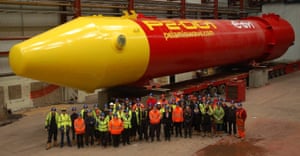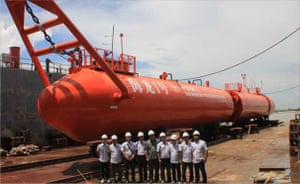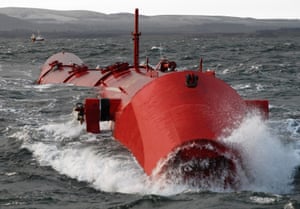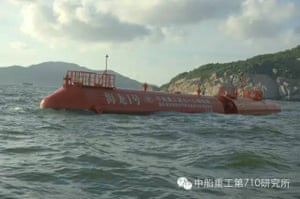Mysterious factory break-in raises suspicions about Chinese visit

A burglary at an innovative Scottish wave-power company went forgotten, until a very similar project appeared in China

It was an unusual burglary, in which four or five laptops were stolen from a Scottish renewable energy manufacturer in the dead of a March night in 2011. So innovative was the company that it had been been visited by a 60-strong delegation led by Chinas then vice-premier only two months before.
Nothing else was taken from the company and the crime, while irritating, went unsolved and forgotten until a few years later pictures began emerging that showed a remarkably similar project manufactured in the worlds most populous country.
Then some people who were involved in the Scottish company, Pelamis Wave Power, started making a connection between the break-in and the politicians visit, which was rounded off with dinner and whisky tasting at Edinburgh Castle hosted by the then Scottish secretary, Michael Moore.
Max Carcas, who was business development director at Pelamis until 2012, said the similarities between the Scottish and Chinese products were striking. Speaking publicly for the first time, he said: Some of the details may be different but they are clearly testing a Pelamis concept.


It might be that Chinas engineers had been working along roughly the same lines as the UK engineers. Or it may be that China attempted to replicate the design based on pictures of the Pelamis project freely available on the web.
Or there could be a darker explanation: that Pelamis was targeted by China, which has been repeatedly accused of pursuing an aggressive industrial espionage strategy. The answer matters, given security concerns raised by the governments award of the Hinkley Point nuclear contract to China.
It was a tremendous feather in our cap to be the only place in the UK outside of London that the Chinese vice-premier visited, Carcas said. We did have a break-in about 10 weeks after, when a number of laptops were stolen. It was curious that whoever broke in went straight to our office on the second floor rather than the other company on the first floor or the ground floor.
Carcas, who is now managing director of the renewable energy consultancy Caelulum, added: I could infer all sorts of things but I do not want to say.

Ironically, Pelamis is now defunct but the Chinese product, Hailong (Dragon) 1, still appears to be under development.
Scotland has been at the forefront of the development of wave technology for decades. Pelamis was one of the cutting-edge companies, originally named the Ocean Power Delivery company when founded in 1998 and renamed Pelamis Wave Power in 2007.
The company, which employed a staff of 50, developed a giant energy wave machine, which it named Pelamis. It looked like a metal snake, facing directly into the waves, harnessing the power of the sea. It had a unique hinged joint system that helped regulate energy flow as waves ran down its length.
Other revolutionary features included a sophisticated control system and a quick mechanism for releasing it into the sea and recovering it. In 2004, it became the first wave-energy machine to generate electricity into the grid.
China expressed interest in December 2010 in an email to Pelamis: It is decided that His Excellency, Mr Li Keqiang, vice-premier of the state council of China, and the delegation (60 people) headed by him will pay a visit to the Pelamis Sea Energy Converter between 16.40 and 17.00 on Sunday 9 January.

Li, who is now premier of China, was accompanied by other senior Chinese government officials and was shown round the key stages in the construction of Pelamis at the site in Leith, Edinburgh.
Moore was his host for the visit and recalled the Chinese had been very impressed. Asked about the coincidence of the visit, the break-in and emergence of a similar Chinese project, Moore said: I am afraid I am not going to speculate. It is intriguing.
The day was rounded off with the dinner at the castle. A Scottish government memo setting out the itinerary said: Evening dinner at castle with whisky tasting, Scottish dancing, crown jewels.
Any faint hopes that the Chinese might invest in the Pelamis project proved fruitless however. Three years later, in November 2014, Pelamis went into administration, having run out of funding after 17 years developing the project at a cost of 95m.
Two months after the Chinese visit, on the night of Monday 22 March 2011, the Pelamis office was broken into. The burglar or burglars managed to get through a perimeter fence and then the front door. They skipped the first-floor office of the German engineering giant Siemens and continued to Pelamis on the second floor.
Police Scotland, in a statement confirming the break-in, said no one had ever been caught. Entry was forced to a business premises on Bath Road in Edinburgh between 11pm 21 March and 6.45 am on 22 March 2011, the police said.
A number of laptops, collectively worth a four-figure sum, were stolen from within. Officers conducted extensive inquiries at the time and any new information received will be thoroughly investigated.
Break-ins at dockyards are not unusual. Pelamis had suffered before when copper cables were stolen from its site. But theft of laptops from its office was a first.
The pictures from China, show that the product, as well as looking roughly the same, also seems to have specific features such as a similar-looking hinged joint system and a similar system for placing in and recovering the project from the sea. Tests on the Hailong 1 were carried out in in 2014 and again in 2015 but on both occasions the tests had to be suspended because of rough seas.

The Hailong 1 appears to have been built at the No 710 Research Institute, part of the Chinese Shipbuilding Industry Corporation, a commercial operation. The institute is also involved in developing military projects.
The Guardian sent a series of questions to the Chinese government asking for details about the origins of the Hailong 1 project but has had no reply. There is no suggestion that the Chinese premier is connected with the company or that he knows anything about the burglary.
Despite the similarities, neither the UK nor Scottish governments has any plans to challenge China over the patent. Calum Macfarlane, a spokesman for Wave Energy Scotland, said: The IP [intellectual property] is not protected in China.
Carn Gibson, who spent 15 years at Pelamis, where he was engineering manager, is disappointed that funding for the Pelamis project could not be found in the UK and appeared sanguine about the Chinese design.
Gibson, who is now senior consulting engineer at Quoceant, a new company that grew out of Pelamis, said he regarded it as a compliment that the Chinese may have thought it was an idea worth copying, especially if they were able to turn it into a viable commercial proposition. He was rueful though that it was being developed in the South China Sea rather than the Atlantic.